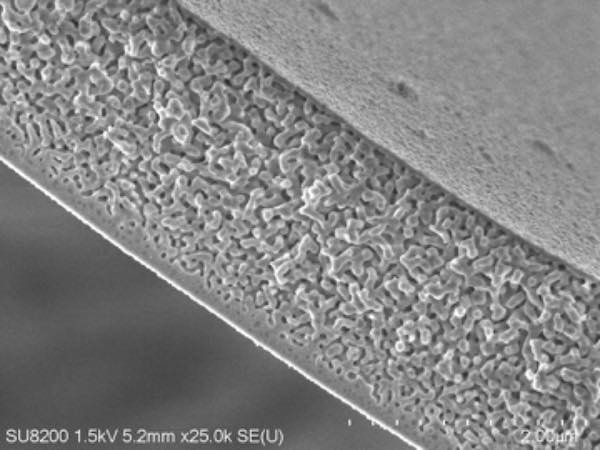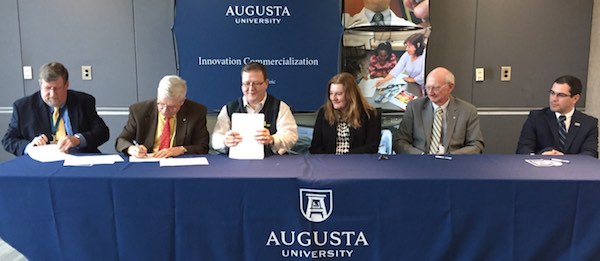
[Image above] SpheroFill LLC founders (left to right) William Hill, George Wicks, and Paul Weinberger sign a license to use patented porous wall, hollow glass microsphere technology for medical applications. Credit: Augusta University
In the June 2008 issue of the ACerS Bulletin, porous wall, hollow glass microspheres made their public debut to the materials world.
In the article, authors George Wicks, L.K. Heung, and R.F. Schumacher introduced the tiny glass microballoons, developed at Savannah River National Lab, and discussed a wide variety of potential applications for the technology.
The glass microspheres are unique and incredibly useful because of their hollow interior and the porosity of their walls—which allow solids, liquids, and gases, stored in the hollow interior, to pass through the microspheres’ walls and be released and delivered on demand.
[If you’re an ACerS member, check out the article here.]
The original Bulletin article discussed the microspheres’ potential applications for nuclear and hydrogen storage, gas purification and separation, and more. But with such a unique and versatile development, there were bound to be many more uses.
Then, in the August 2016 issue of the ACerS Bulletin, Wicks and coauthors Grant Crawford, Jon Keller, Fred Humes, and Forest Thompson introduced another intriguing possible application for the microspheres—anticounterfeiting strategies.
The team described the incredible potential of microspheres filled with security materials to develop a whole new breed of security inks that can respond to outside stimuli on demand, in an effort to combat the staggering $1.77 trillion global market for counterfeit goods.

Aggregate micrograph of porous wall, hollow glass microspheres.

Micrograph showing the porous wall of the microspheres.
And now, nearly a decade after their initial introduction, porous wall, hollow glass microspheres are diving into another incredibly lucrative market direction—medical applications.
The Applied Research Center LLC and Augusta University, which collaborated to develop the microspheres’ medical potential, have now jointly licensed the patented technology to SpheroFill LLC (Augusta, Ga.), a startup company specially focusing on biomedical applications of the microspheres.
SpheroFill was founded by George Wicks, chief technology officer at the Applied Research Center, Paul Weinberger, former otolaryngology surgeon at Augusta University, and William Hill, professor of cellular biology and anatomy at Augusta University.
“The main goal of our company is to bring this technology to where it can actually start affecting lives,” says Weinberger, president of SpheroFill.

(Left to right) William Hill, SpheroFill; George Wicks, SpheroFill; Paul Weinberger, SpheroFill; Sarah White, Augusta University; Fred Humes, Applied Research Center; and Matthew Biasiny, SRNL, at SpheroFill’s signing of the license. Credit: August University
And that potential to affect lives is huge, because the microspheres can be filled with medications and their surfaces can be enhanced with bioactive coatings. “The microspheres can then be injected locally and programmed for a controlled release of the drug. The possibilities for the hollow spheres and delivery of the ‘cargo’ they contain will have far-reaching advantages to medical professionals,” according to a recent press release.
For instance, the glass microspheres have potential applications in restorative medicine, treatment of laryngeal issues, and cosmetics, to name just a few. “In the human body, a modified version of the compound could be used to deliver medication to a targeted region, releasing the drug at will and on a schedule.”
“This really represents a very exciting, new class of composite materials developed by an interdisciplinary team,” Wicks says. “In key areas of the medical profession, there seems to be a whole host of potential uses, including a variety of new products in diagnostics, repair of body parts, and in therapy technologies.”
SpheroFill will initially focus on developing microsphere-based treatments for voice disorders in older individuals and as tissue filler for cosmetic surgery, according to the release. The company also plans to develop the technology for muscle and bone repair for military use.
However, SpheroFill also has an ambitious long-term goal for the microspheres—tackling cancer treatment.
“One of the real advantages of being able to do things very specifically and locally, for example treating a tumor, is that we can use higher doses within a very limited area without having side effects common in a systemic treatment,” Hill says. “Cancer treatment is a big thing in the future for us.”
